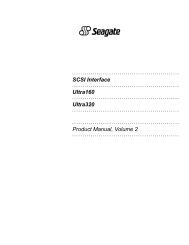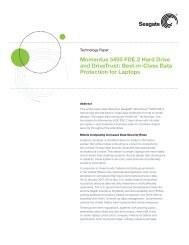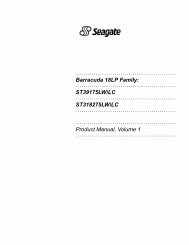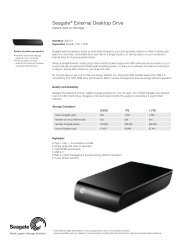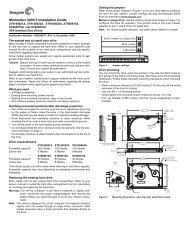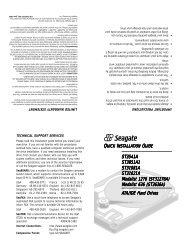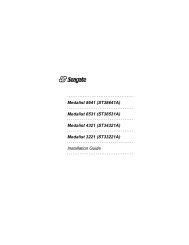Quickview 300 Product Manual PATA - Seagate
Quickview 300 Product Manual PATA - Seagate
Quickview 300 Product Manual PATA - Seagate
Create successful ePaper yourself
Turn your PDF publications into a flip-book with our unique Google optimized e-Paper software.
Glossary<br />
BPI – Abbreviation for bits per inch. A<br />
measure of how densely information is packed<br />
on a storage medium. Flux changes per inch is<br />
also a term commonly used in describing<br />
storage density on a magnetic surface.<br />
BUFFER – An area of RAM reserved for<br />
temporary storage of data that is waiting to be<br />
sent to a device that is not yet ready to receive<br />
it. The data is usually on its way to or from the<br />
disk drive or some other peripheral device.<br />
BUS – The part of a chip, circuit board, or<br />
interface designed to send and receive data.<br />
BYTE – The basic unit of computer<br />
memory, large enough to hold one character<br />
of alphanumeric data. Comprised of eight bits.<br />
See also bit.<br />
C<br />
CACHE – Random-access memory used as a<br />
buffer between the CPU and a hard disk.<br />
Information more likely to be read or changed<br />
is placed in the cache, where it can be accessed<br />
more quickly to speed up general data flow.<br />
CAPACITY – The amount of information<br />
that can be stored on a disk drive. The data is<br />
stored in bytes, and capacity is usually<br />
expressed in megabytes.<br />
CDB – Command Descriptor Block. The<br />
SCSI structure used to communicate requests<br />
from an initiator (system) to a target (drive).<br />
CLEAN ROOM – An environmentally<br />
controlled dust-free assembly or repair facility<br />
in which hard disk drives are assembled or can<br />
be opened for internal servicing.<br />
CLUSTER – A group of sectors on a disk<br />
drive that is addressed as one logical unit by<br />
the operating system.<br />
CONTROLLER – Short form of disk<br />
controller. The chip or complete circuit that<br />
translates computer data and commands into a<br />
form suitable for use by the disk drive.<br />
CONTROLLER CARD – An adapter<br />
holding the control electronics for one or<br />
more hard disks, usually installed in a slot in<br />
the computer.<br />
CPU – Acronym for Central Processing Unit.<br />
The microprocessor chip that performs the<br />
bulk of data processing in a computer.<br />
CRC – Acronym for Cyclic Redundancy Check.<br />
An error detection code that is recorded<br />
within each sector and is used to see whether<br />
parts of a string of data are missing or<br />
erroneous.<br />
CYLINDER – On a disk drive that has more<br />
than one recording surface and heads that<br />
move to various tracks, the group of all tracks<br />
located at a given head position. The number<br />
of cylinders times the number of heads equals<br />
the number of tracks per drive.<br />
D<br />
DATA SEPARATOR – On a disk drive<br />
that stores data and timing information in an<br />
encoded form, the circuit that extracts the<br />
data from the combined data and clock signal.<br />
DEDICATED SERVO – A surface separate<br />
from the surface used for data that contains<br />
only disk timing and positioning information<br />
and contains no data.<br />
DEFECT MANAGEMENT – A method<br />
that is implemented to ensure long term data<br />
integrity. Defect management eliminates the<br />
need for user defect maps. This is<br />
accomplished by scanning the disk drives at<br />
the factory for defective sectors. Defective<br />
sectors are deallocated prior to shipment. In<br />
addition, during regular use, the drive<br />
continues to scan and compensate for any new<br />
defective sectors on the disk.<br />
DISK – In general, any circular-shaped<br />
data-storage medium that stores data on the<br />
flat surface of the platter. The most common<br />
type of disk is the magnetic disk, which stores<br />
data as magnetic patterns in a metal or<br />
metal-oxide coating. Magnetic disks come in<br />
two forms: floppy and hard. Optical recording<br />
is a newer disk technology that gives higher<br />
capacity storage but at slower access times.<br />
G-2 <strong>Quickview</strong> <strong>300</strong> 80/100/120/160/200/250/<strong>300</strong>GB <strong>PATA</strong>



